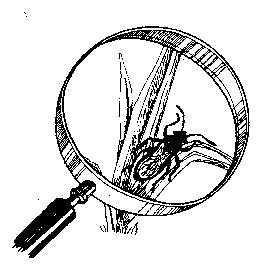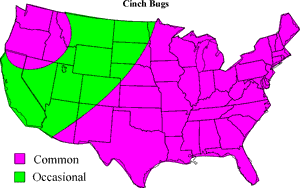 |
Adult chinch bugs are only about 1/5 inch long, about the size of a ladybug. They have black bodies marked by a black triangular pad which separates white, folded wings. Immature bugs, called nymphs, are reddish colored. Chinch bugs cluster in lawns down among grass blades near the crowns of the grass plants and suck juices from their tissues. Their feeding causes grass to appear yellowish and sometimes stains the grass red. These bugs thrive in hot, dry weather, becoming active when temperatures are in the high 70s.
Chinch bugs are called hairy chinch bugs in the North. The pests are so small and inconspicuous that they can destroy a lawn right beneath your eyes without being noticed. Aside from lawns, chinch bugs have long been notorious as serious pests of grain crops such as wheat, rye, oats, barley, sorghum, and corn.
 |
Their Growth Stages - Chinch bugs damage turfgrass in each of their stages of development from nymph to mature adult. Overwintering adult chinch bugs hibernate in the thatch and upper layer of the soil under the lawn. They become active in March, laying eggs in the thatch and around the crowns of grass plants. The second generation causes the most problems from August to September, when Northern grasses are stressed from the summer heat. Lower than average temperatures plus moisture retards chinch bug activity.
 |
Chinch bugs breed once a year in Canada and New England but twice a year in the mid-Atlantic region. They occur throughout most of the country, but are worst in the Midwest, East, and South. In the Northeast they are most fond of Kentucky bluegrass and red fescue. In the South, southern chinch bugs are particular pests of St. Augustine, Bermuda and zoysia grasses. They may remain partially active throughout the winter. If you grow St. Augustine grass, plant the chinch bug-resistant ‘Floratam’ variety, or switch to centipede grass which is not attacked by chinch bugs.
Most common turfgrass targets of chinch bugs:
- Bent grass
- Bermuda grass
- Kentucky bluegrass
- Red Fescue
- St. Augustine grass
- Zoysia grass
Turfgrasses resistant to chinch bugs:
- Centipede grass
- St. Augustine grass varieties ‘Floratam’, ‘Floralawn’, and ‘Floratine’.

